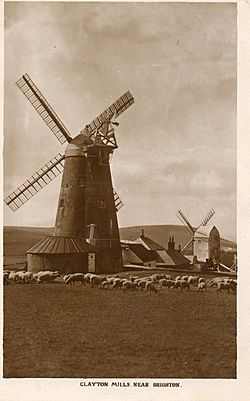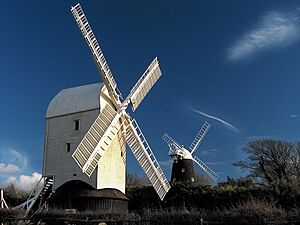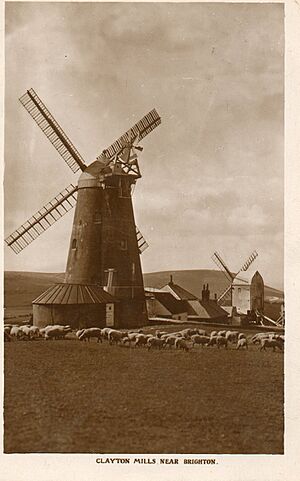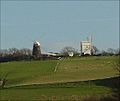Clayton Windmills facts for kids
The Clayton Windmills are two famous windmills in Clayton, West Sussex, England. People often call them Jack and Jill. They stand tall on the South Downs hills. These windmills include a special type called a post mill and another called a tower mill. There's also the round base of an even older windmill. All three are very important historical buildings, protected by law.
Contents
Where are the Windmills?
These amazing windmills are located on top of the South Downs hills. From here, you can see beautiful views of the Sussex Weald. They are about 7 miles (11 km) north of the city of Brighton and Hove. Besides Jack and Jill, you can also see the round base of an old windmill called Duncton Mill. It's just a short walk east of Jack.
You can easily reach the windmills by car. Just follow Mill Lane from the A273 road where it crosses the South Downs. There's a free car park right next to the windmills.
The History of the Windmills
Duncton Mill: The Oldest One
Quick facts for kids Duncton Mill |
|
|---|---|
| Origin | |
| Grid reference | TQ 304 135 |
| Coordinates | 50°54′19″N 0°08′51″W / 50.9052°N 0.1475°W |
| Operator(s) | Jack and Jill Windmills Society |
| Year built | 1765 |
| Information | |
| Purpose | Corn mill |
| Type | Post mill |
| Roundhouse storeys | Single storey roundhouse |
| No. of sails | Four |
| Type of sails | Common sails |
| Winding | Tailpole |
| No. of pairs of millstones | Two pairs, arranged Head and Tail |
| Other information | Demolished in 1866, roundhouse remains standing. |
Duncton Mill was built a long time ago, in 1765. It was owned by a nobleman called Viscount Montague. This windmill was taken down in 1866. Only its round base, called a roundhouse, was left behind. It was then used as a storage building.
What Duncton Mill Looked Like
Duncton Mill was a post mill. This means its whole body could turn to face the wind. It had a single-storey roundhouse at its base. The mill had four common sails, which are a simple type of windmill sail. Workers had to turn the mill by hand to catch the wind. It also had two pairs of millstones to grind corn. An interesting fact is that a part from Duncton Mill, called the head wheel, was later used in Jack windmill!
Jill: The Moving Mill
| 'Jill' | |
|---|---|

Jill (foreground) and Jack (background)
|
|
| Origin | |
| Grid reference | TQ 304 134 |
| Operator(s) | Jack and Jill Windmills Society |
| Year built | 1821 |
| Information | |
| Purpose | Corn mill |
| Type | Post mill |
| Base storeys | Two storey roundhouse |
| No. of sails | Four |
| Type of sails | Patent sails |
| Windshaft | Wood, with cast iron poll end |
| Winding | Tailpole mounted fantail |
| Fantail blades | Five blades |
| No. of pairs of millstones | Two pairs, arranged head and tail |
| Other information | Moved from Brighton in 1852. Main post constructed of four pieces of timber. |
Jill is also a post mill. It was first built in 1821 in Dyke Road, Brighton. It was known as Lashmar's New Mill back then. In 1830, the part that holds the sails broke, and the sails fell down! In 1852, Jill was moved all the way to Clayton using a team of horses and oxen. Imagine moving a whole windmill!
The windmills stopped working in 1906. In 1908, Jill was damaged in a big storm. Over the years, she lost her fantail (a small windmill that turns the main mill) and her sails. In 1953, some repairs were done. Then, in 1978, work began to get Jill working again. She finally ground flour once more in 1986!
During the Great Storm of 1987, Jill almost caught fire! The strong winds were so powerful they turned the sails even though the brakes were on. This caused a lot of heat and started a fire. Luckily, members of the Windmill Society rushed to the mill and put out the fire by carrying water up the hill. They saved her!
Today, Jill is still in working order. You can visit her most Sundays between May and September. She sometimes grinds wholemeal flour from organic wheat grown nearby in Sussex. Most of this flour is sold to visitors. When the wind is blowing and Jill is working, a guide is there to explain how the milling process works. Jill is owned by Mid Sussex District.
How Jill is Built
Jill is a post mill with a two-storey roundhouse. She has four patent sails, which are a more advanced type of sail. A five-blade windmill fantail on her tailpole helps her turn to face the wind automatically. The main shaft that holds the sails is made of wood, with a special cast iron end from 1831. Jill has two pairs of millstones for grinding. Her main post, which supports the whole mill, is made from four separate pieces of timber. This is a special feature found in only a few windmills in Sussex.
Jack: The Tower Mill
| 'Jack' | |
|---|---|

Jack, with the roundhouse of Duncton Mill in the foreground
|
|
| Origin | |
| Grid reference | TQ 304 135 |
| Year built | 1866 |
| Information | |
| Purpose | Corn mill |
| Type | Tower mill |
| Storeys | Five storeys |
| No. of sails | Four |
| Type of sails | Patent sails |
| Windshaft | Cast iron |
| Winding | Fantail |
| Fantail blades | Five blades |
| Other information | Was fitted with Hammond's Patent Sweep Governor. Brake wheel was formerly in Duncton Mill. |
Jack is a five-storey tower mill. It was built in 1866 to replace the old Duncton Mill. Jack and Jill worked together as a pair until around 1907. It's quite unusual for a windmill to have a male name like Jack, as most windmills in England are thought of as female!
In 1928, something interesting was found near Jack. While digging for a water tank, workers discovered an Anglo-Saxon skeleton! It was later moved to the British Museum. The present owners have lived at the windmill since 2012.
How Jack is Built
Jack is a five-storey tower mill with a rounded top, called a domed cap. He has four patent sails and was turned by a five-blade fantail. There was also a platform at the first floor level. It is thought that a mill builder named Cooper, from Henfield, built Jack. In 1873, Jack was fitted with a special device called Hammond's Patent Sweep Governor. This helped control the speed of the sails.
Jack used to have three pairs of millstones for grinding, with space for a fourth. However, all the machinery inside below the windshaft has been removed. In 1966, Jack got new sails because he was going to be in a film! Jack is about 44 feet (13.4 meters) tall to the top of his tower. He is about 22 feet 8 inches (6.9 meters) wide at the bottom and 13 feet (4 meters) wide at the top.
Millers Who Worked Here
Here are some of the people who worked as millers at Duncton Mill, Jack, and Jill over the years:
- Edward Horam (Duncton): 1765–1787
- John Geere (Duncton): 1809
- Thomas Hicks (Duncton): 1810
- John Hamlin (Duncton): 1816
- James Mitchell (Duncton, Jack, Jill): 1838–1872
- Joseph Hammond (Jack, Jill): 1872–1882
- Charles Hammond (Jack, Jill): 1872–1905
- Guy (Jack, Jill): 1905–1907
Images for kids
See also
- Grade II* listed buildings in West Sussex







